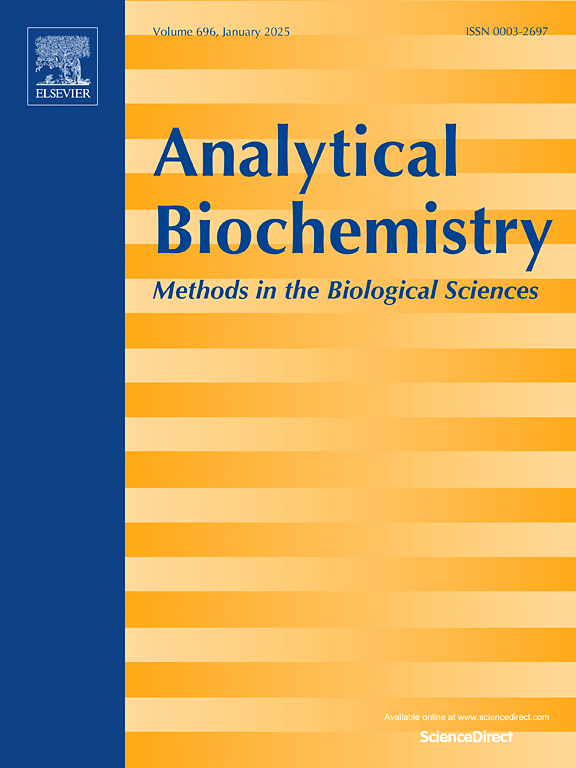Validation of assay for measuring acetyl-coenzyme a carboxylase activity in grasses using malachite green
IF 2.6
4区 生物学
Q2 BIOCHEMICAL RESEARCH METHODS
引用次数: 0
Abstract
Acetyl-CoA carboxylase (ACCase) is one of the most important enzymes as a herbicide target in gramineous plant species, however, assay methods for the enzyme are primarily limited to those using radioisotopes (RI). Typically, the measurement method that uses RI necessitates specialized facilities and equipment, and involves complex procedures throughout the experiment. As another method for detecting ACCase activity, the colorimetric method using malachite green (MG) is also known. However, reports on this method are limited, and information regarding the simplicity of the procedure and the scope of its application remains unclear. To better understand the method using MG and to develop a simpler assay method, crude enzymes extracted from various target-site resistant (TSR) biotypes of blackgrass (Alopecurus myosuroides) were examined in enzyme inhibition tests. As a result, this method was able to accurately detect the relationship between the chemical classes of ACC inhibitors and cross-resistance to specific TSRs. Moreover, the ACCase activity of other grass species was also examined using this method. By using crude enzymes from various species and a commercially available phosphatase kit containing MG, ACCase activity was detectable with good accuracy. In addition, enzyme inhibition studies using ACCase inhibiting herbicides revealed that this method reproduced results similar to those obtained with the RI method. The Z′-factor, an index of high-throughput screening (HTS), was around 0.7, indicating that it is an excellent screening system. These results suggest that the assay method using MG is very simple, labor-saving, and accurate with a throughput much higher than that of the existing RI method. Therefore, it is strongly suggested that the method could replace the RI method in most cases. These results indicate that it is applicable to HTS for ACCase inhibitors.

利用孔雀石绿验证测定草中乙酰辅酶 A 羧化酶活性的方法
乙酰-CoA羧化酶(ACCase)是禾本科植物中作为除草剂靶标的最重要的酶之一,但该酶的检测方法主要局限于使用放射性同位素(RI)的方法。通常,使用放射性同位素的测量方法需要专门的设施和设备,而且整个实验过程涉及复杂的程序。另一种检测 ACCase 活性的方法是使用孔雀石绿(MG)的比色法。然而,有关这种方法的报道并不多,而且有关该方法的简易性及其应用范围的信息仍不明确。为了更好地理解使用孔雀石绿的方法,并开发出一种更简单的检测方法,我们在酶抑制试验中检测了从黑草(Alopecurus myosuroides)的各种抗靶点(TSR)生物型中提取的粗酶。结果,这种方法能够准确检测 ACC 抑制剂化学类别与对特定 TSR 的交叉抗性之间的关系。此外,该方法还检测了其他草种的 ACC 酶活性。通过使用来自不同草种的粗酶和含有 MG 的市售磷酸酶试剂盒,可以很准确地检测到 ACC 酶活性。此外,使用抑制 ACCase 的除草剂进行的酶抑制研究表明,该方法可再现与 RI 方法类似的结果。作为高通量筛选(HTS)指标的 Z'因子约为 0.7,表明这是一种出色的筛选系统。这些结果表明,使用 MG 的检测方法非常简单、省力、准确,其通量远远高于现有的 RI 方法。因此,强烈建议该方法在大多数情况下可以取代 RI 方法。这些结果表明它适用于 ACCase 抑制剂的 HTS。
本文章由计算机程序翻译,如有差异,请以英文原文为准。
求助全文
约1分钟内获得全文
求助全文
来源期刊

Analytical biochemistry
生物-分析化学
CiteScore
5.70
自引率
0.00%
发文量
283
审稿时长
44 days
期刊介绍:
The journal''s title Analytical Biochemistry: Methods in the Biological Sciences declares its broad scope: methods for the basic biological sciences that include biochemistry, molecular genetics, cell biology, proteomics, immunology, bioinformatics and wherever the frontiers of research take the field.
The emphasis is on methods from the strictly analytical to the more preparative that would include novel approaches to protein purification as well as improvements in cell and organ culture. The actual techniques are equally inclusive ranging from aptamers to zymology.
The journal has been particularly active in:
-Analytical techniques for biological molecules-
Aptamer selection and utilization-
Biosensors-
Chromatography-
Cloning, sequencing and mutagenesis-
Electrochemical methods-
Electrophoresis-
Enzyme characterization methods-
Immunological approaches-
Mass spectrometry of proteins and nucleic acids-
Metabolomics-
Nano level techniques-
Optical spectroscopy in all its forms.
The journal is reluctant to include most drug and strictly clinical studies as there are more suitable publication platforms for these types of papers.
 求助内容:
求助内容: 应助结果提醒方式:
应助结果提醒方式:


